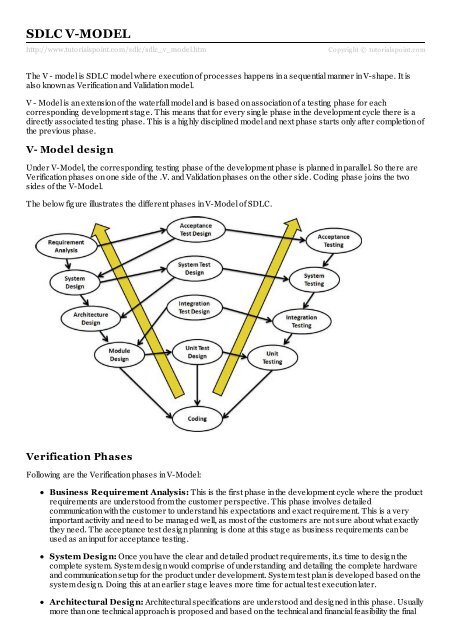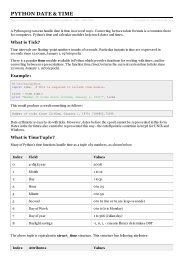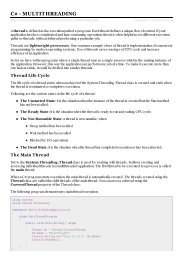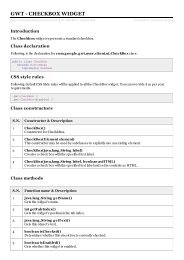SDLC V-Model - Tutorials Point
SDLC V-Model - Tutorials Point
SDLC V-Model - Tutorials Point
Create successful ePaper yourself
Turn your PDF publications into a flip-book with our unique Google optimized e-Paper software.
<strong>SDLC</strong> V-MODEL<br />
http://www.tuto rialspo int.co m/sdlc/sdlc_v_mo del.htm<br />
Copyrig ht © tutorialspoint.com<br />
The V - model is <strong>SDLC</strong> model where execution of processes happens in a sequential manner in V-shape. It is<br />
also known as Verification and Validation model.<br />
V - <strong>Model</strong> is an extension of the waterfall model and is based on association of a testing phase for each<br />
corresponding development stag e. This means that for every sing le phase in the development cycle there is a<br />
directly associated testing phase. This is a hig hly disciplined model and next phase starts only after completion of<br />
the previous phase.<br />
V- <strong>Model</strong> desig n<br />
Under V-<strong>Model</strong>, the corresponding testing phase of the development phase is planned in parallel. So there are<br />
Verification phases on one side of the .V. and Validation phases on the other side. Coding phase joins the two<br />
sides of the V-<strong>Model</strong>.<br />
The below fig ure illustrates the different phases in V-<strong>Model</strong> of <strong>SDLC</strong>.<br />
Verification Phases<br />
Following are the Verification phases in V-<strong>Model</strong>:<br />
Business Requirement Analysis: This is the first phase in the development cycle where the product<br />
requirements are understood from the customer perspective. This phase involves detailed<br />
communication with the customer to understand his expectations and exact requirement. This is a very<br />
important activity and need to be manag ed well, as most of the customers are not sure about what exactly<br />
they need. The acceptance test desig n planning is done at this stag e as business requirements can be<br />
used as an input for acceptance testing .<br />
System Desig n: Once you have the clear and detailed product requirements, it.s time to desig n the<br />
complete system. System desig n would comprise of understanding and detailing the complete hardware<br />
and communication setup for the product under development. System test plan is developed based on the<br />
system desig n. Doing this at an earlier stag e leaves more time for actual test execution later.<br />
Architectural Desig n: Architectural specifications are understood and desig ned in this phase. Usually<br />
more than one technical approach is proposed and based on the technical and financial feasibility the final
decision is taken. System desig n is broken down further into modules taking up different functionality. This<br />
is also referred to as Hig h Level Desig n (HLD).<br />
The data transfer and communication between the internal modules and with the outside world (other<br />
systems) is clearly understood and defined in this stag e. With this information, integ ration tests can be<br />
desig ned and documented during this stag e.<br />
Module Desig n:In this phase the detailed internal desig n for all the system modules is specified,<br />
referred to as Low Level Desig n (LLD). It is important that the desig n is compatible with the other<br />
modules in the system architecture and the other external systems. Unit tests are an essential part of any<br />
development process and helps eliminate the maximum faults and errors at a very early stag e. Unit tests<br />
can be desig ned at this stag e based on the internal module desig ns.<br />
Coding Phase<br />
The actual coding of the system modules desig ned in the desig n phase is taken up in the Coding phase. The best<br />
suitable prog ramming lang uag e is decided based on the system and architectural requirements. The coding is<br />
performed based on the coding g uidelines and standards. The code g oes throug h numerous code reviews and<br />
is optimized for best performance before the final build is checked into the repository.<br />
Validation Phases<br />
Following are the Validation phases in V-<strong>Model</strong>:<br />
Unit Testing : Unit tests desig ned in the module desig n phase are executed on the code during this<br />
validation phase. Unit testing is the testing at code level and helps eliminate bug s at an early stag e, thoug h<br />
all defects cannot be uncovered by unit testing .<br />
Integ ration Testing : Integ ration testing is associated with the architectural desig n phase. Integ ration<br />
tests are performed to test the coexistence and communication of the internal modules within the system.<br />
System Testing : System testing is directly associated with the System desig n phase. System tests<br />
check the entire system functionality and the communication of the system under development with external<br />
systems. Most of the software and hardware compatibility issues can be uncovered during system test<br />
execution.<br />
Acceptance Testing : Acceptance testing is associated with the business requirement analysis phase<br />
and involves testing the product in user environment. Acceptance tests uncover the compatibility issues<br />
with the other systems available in the user environment. It also discovers the non functional issues such as<br />
load and performance defects in the actual user environment.<br />
V- <strong>Model</strong> Application<br />
V- <strong>Model</strong> application is almost same as waterfall model, as both the models are of sequential type. Requirements<br />
have to be very clear before the project starts, because it is usually expensive to g o back and make chang es.<br />
This model is used in the medical development field, as it is strictly disciplined domain. Following are the suitable<br />
scenarios to use V-<strong>Model</strong>:<br />
Requirements are well defined, clearly documented and fixed.<br />
Product definition is stable.<br />
Technolog y is not dynamic and is well understood by the project team.<br />
There are no ambig uous or undefined requirements.<br />
The project is short.<br />
V- <strong>Model</strong> Pros and Cons<br />
The advantag e of V-<strong>Model</strong> is that it.s very easy to understand and apply. The simplicity of this model also makes<br />
it easier to manag e. The disadvantag e is that the model is not flexible to chang es and just in case there is a<br />
requirement chang e, which is very common in today.s dynamic world, it becomes very expensive to make the<br />
chang e.
The following table lists out the pros and cons of V-<strong>Model</strong>:<br />
Pros<br />
Cons<br />
This is a hig hly disciplined model and Phases<br />
are completed one at a time.<br />
Works well for smaller projects where<br />
requirements are very well understood.<br />
Simple and easy to understand and use.<br />
Easy to manag e due to the rig idity of the<br />
model . each phase has specific deliverables<br />
and a review process.<br />
Hig h risk and uncertainty.<br />
Not a g ood model for complex and objectoriented<br />
projects.<br />
Poor model for long and ong oing projects.<br />
Not suitable for the projects where<br />
requirements are at a moderate to hig h risk of<br />
chang ing .<br />
Once an application is in the testing stag e, it is<br />
difficult to g o back and chang e a functionality<br />
No working software is produced until late<br />
during the life cycle.

















